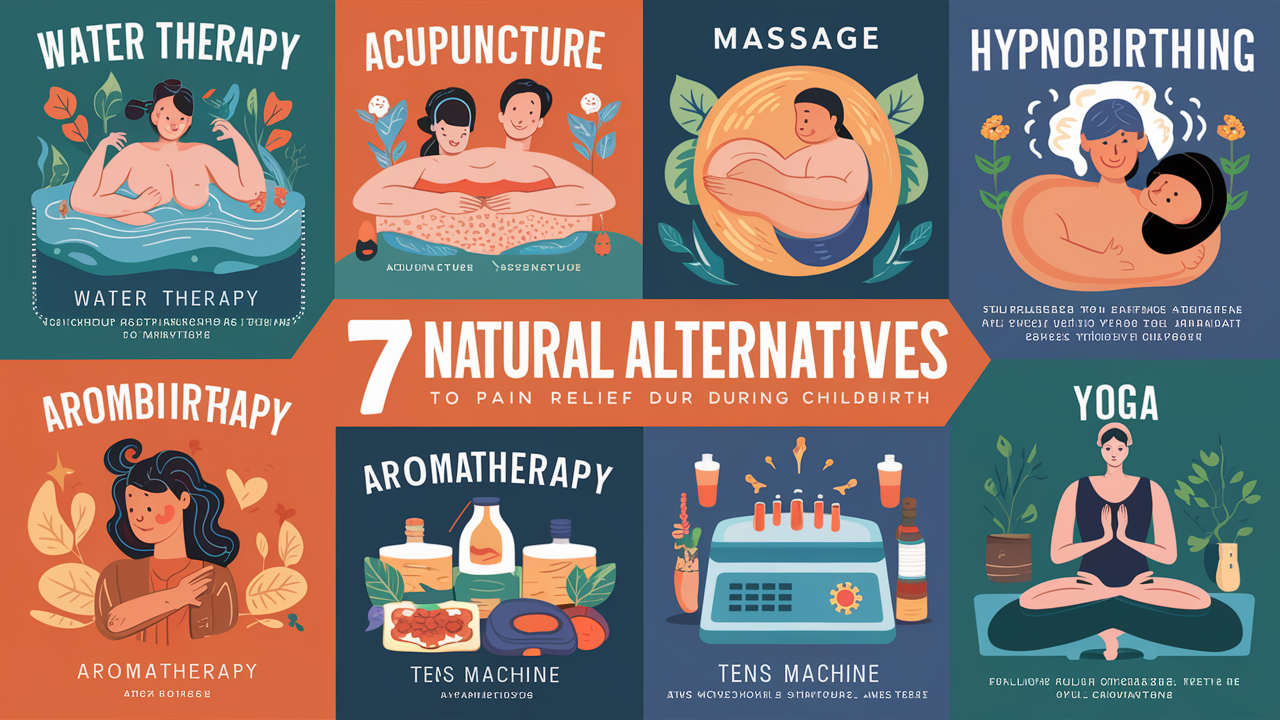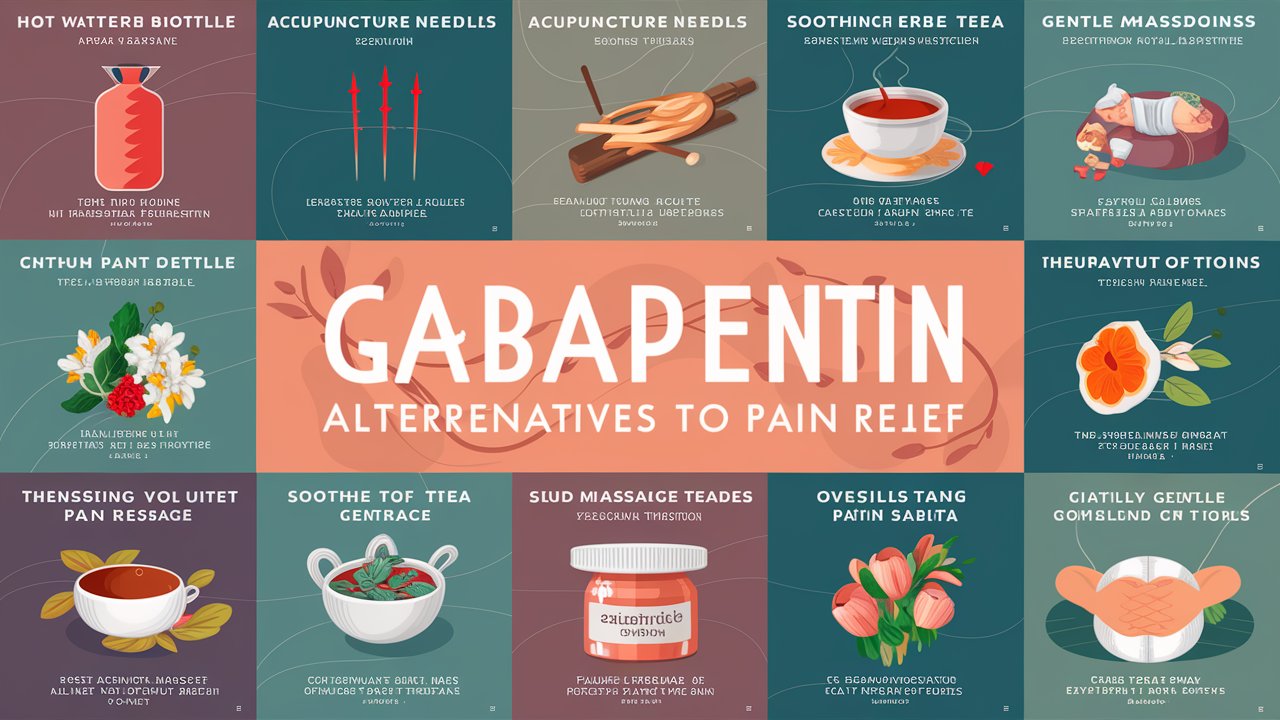| Natural Alternative | Pros | Cons |
|---|---|---|
| 1. Breathing Techniques | – Helps deliver adequate oxygen to both mother and baby. – Eases feelings of nausea. | – Might not provide complete pain relief throughout labor. |
| 2. Essential Oils | – Promotes relaxation. – Creates a soothing environment. | – Some essential oils may not be suitable for all individuals. |
| 3. Soft Lighting | – Helps ease tension and anxiety. | – Requires a conducive environment which may not always be available. |
| 4. Calming Music | – Promotes relaxation. – Aids in reducing stress. | – Personal preference for music varies. |
| 5. Quiet Voices | – Contributes to a calming atmosphere. | – External factors may disrupt the quiet environment. |
| 6. Calming Images | – Provides visual relaxation. | – Individual preferences for images differ. |
| 7. Lamaze Techniques | – Teaches specific breathing and relaxation techniques. – Helps manage labor pain effectively. | – Requires practice and preparation before labor. |
| 8. Bradley Method | – Focuses on partner involvement. – Emphasizes natural childbirth techniques. | – Might not be suitable for all birthing situations. |
| 9. Standing Positions | – Can aid in pain relief and progress labor. | – May not be comfortable for extended periods. |
| 10. Squatting | – Facilitates the descent of the baby. – Can help relieve back pressure. | – Requires physical strength and flexibility. |
| 11. Lunging | – Promotes pelvic opening. – Alleviates discomfort. | – Might be challenging for some individuals. |
| 12. Deep Breathing | – Enhances oxygen flow. – Supports relaxation. | – Requires focus and practice. |
| 13. Change of Positions | – Helps manage pain and progress labor. | – Continuous position changes may be tiring. |
| 14. Nitrous Oxide | – Provides quick pain relief. – Allows for mobility and self-administration. – Simple to administer. | – May be less effective than epidural for some individuals. – Not universally available. – Some may find the mask uncomfortable. – Effectiveness varies among individuals. |
| 15. Pudendal Blocks | – Numbs the vaginal area quickly. – Useful for specific procedures during labor. | – Requires medical expertise for administration. – Limited to specific situations. |
In the tapestry of childbirth experiences, the choice of pain management during labor is a pivotal thread that weaves through the journey of expecting mothers.
While epidurals have long been a familiar option, there exists a realm of natural alternatives waiting to be explored—each holding the promise of empowerment and unique benefits for those on the precipice of motherhood.
Inviting you to step off the beaten path and into a world where mindfulness meets birthing choices, we embark on a quest to discover seven natural alternatives to epidural.
Embracing the essence of empowerment, we champion a mindful exploration of alternative birthing options that transcend conventional norms and open doors to diverse possibilities.
Imagine delving into herbal remedies, harnessing the soothing power of aromatherapy, or embarking on a journey through hypnobirthing realms—all poised to offer not just relief but also newfound perspectives on birth.
Join us as we traverse through holistic avenues towards childbirth, unearthing solutions that blend ancient wisdom with modern practices in a harmonious symphony aimed at revolutionizing your pregnancy experience.
Let’s dive deeper into these transformative alternatives and set sail on a voyage where empowerment takes center stage in navigating your unique path towards motherhood.
Herbal Remedies and Aromatherapy: Natural Allies in Labor and Delivery.
When it comes to navigating the beautiful yet intense journey of labor and delivery, herbal remedies and aromatherapy stand out as gentle yet potent alternatives to traditional pain management methods. Imagine harnessing the power of nature’s healing touch to ease discomfort and enhance relaxation during childbirth.
Herbal remedies like ginger for nausea, chamomile for calming nerves, or raspberry leaf tea for toning the uterus can be valuable allies on your birthing team. These natural options not only address physical symptoms but also nurture a holistic approach to well-being, supporting both body and mind.
Aromatherapy, with its delightful scents and therapeutic properties, offers a sensory escape amidst the intensity of labor. Picture diffusing lavender essential oil to promote relaxation or using peppermint oil for its uplifting effects during moments of fatigue.
By incorporating these aromatic essences into your birth environment, you create a soothing ambiance that fosters tranquility and aids in pain relief.
Together, herbal remedies and aromatherapy form a dynamic duo that empowers you to embrace a more natural path towards childbirth—one that resonates with your body’s innate wisdom while honoring the miraculous process unfolding within you.
As you embark on this exploration of natural alternatives, consider delving deeper into the world of herbal remedies and aromatherapy to discover which blends and scents resonate most with your unique needs and preferences.
By engaging with these age-old practices in a mindful and intentional manner, you pave the way for a more personalized birthing experience—one that celebrates the harmony between ancient wisdom and modern empowerment. Let nature’s bounty guide you as you navigate labor pains with grace, resilience, and a newfound sense of connection to the earth’s healing energies.
In embracing herbal remedies and aromatherapy as integral components of your childbirth journey, you open doors to profound healing potentials that extend far beyond mere pain relief.
These natural alternatives invite you to redefine your understanding of strength, resilience, and self-care during one of life’s most transformative moments—empowering you to approach labor and delivery with curiosity, trust in your body’s capabilities, and an unwavering spirit of openness towards new possibilities.
Hypnobirthing and mindfulness.
Hypnobirthing and mindfulness techniques offer expecting mothers a powerful toolkit for achieving calm and fear-free birthing experiences. Hypnobirthing revolves around the idea of using self-hypnosis, relaxation techniques, and positive affirmations to manage labor pains and cultivate a serene environment during childbirth.
By tapping into the mind-body connection, hypnobirthing empowers women to feel in control of their bodies and their birthing journey. Imagine being able to approach labor with a sense of peace and confidence, guided by your inner strength as you welcome your new arrival.
In parallel, practicing mindfulness techniques can be a game-changer in enhancing relaxation and coping skills during labor. Mindfulness invites mothers-to-be to stay present in the moment, acknowledging sensations without judgment or resistance.
Picture yourself embracing each contraction with a mindful awareness that allows you to ride the waves of intensity with grace and composure. These techniques not only help manage pain but also foster resilience and mental clarity amidst the whirlwind of emotions that come with childbirth.
By incorporating hypnobirthing practices alongside mindfulness techniques, expectant mothers are equipped with a holistic approach to navigate the challenges of labor with serenity and empowerment.
Through embracing these alternative methods, women can rewrite their birthing narratives from ones filled with anxiety and doubt to stories marked by strength, mindfulness, and profound connection. As you explore these alternatives, keep an open mind to discover which tools resonate best with you on your unique birthing journey.
Acupuncture and acupressure.
Acupuncture and acupressure offer natural alternatives to alleviate labor pains and promote a smoother progression of labor, empowering expecting mothers with effective pain management options. Acupuncture involves the insertion of thin needles into specific points on the body to stimulate energy flow and promote natural healing processes.
By targeting key acupoints related to pain relief during labor, acupuncture can help reduce discomfort and support a more comfortable birthing experience. Embracing this ancient Chinese practice opens up new possibilities for pain management beyond traditional medical interventions.
On the other hand, acupressure harnesses the power of touch by applying pressure to specific points on the body, offering similar benefits to acupuncture without the use of needles.
Expecting mothers can engage in simple acupressure techniques either independently or with the assistance of a trained practitioner to relieve pain and facilitate labor progress naturally.
By exploring these gentle yet powerful methods, women have the opportunity to enhance their birthing experiences through holistic practices that focus on overall well-being.
Imagine Sarah, a first-time mother-to-be, who decided to incorporate acupressure into her birth plan after learning about its benefits from her prenatal yoga instructor.
During labor, Sarah’s partner gently applied pressure to her lower back using acupressure techniques recommended by their doula, helping Sarah manage contractions and find moments of comfort amidst intensity.
Through these alternating pressures on specific points correlated with pain relief, Sarah felt empowered and actively engaged in her birthing journey, realizing the profound impact touch therapy could have on her childbirth experience.
By embracing acupuncture and acupressure as valuable alternatives to epidural anesthesia, expecting mothers open themselves up to a world of natural pain management techniques that not only address physical discomfort but also nurture emotional well-being during childbirth.
These practices invite individuals to discover their inner resilience while tapping into centuries-old wisdom that honors the intricate connection between mind, body, and spirit in the miraculous journey of bringing new life into the world.
Water Birth and Hydrotherapy: Discovering the Depths of Comfort and Relief.
Immersing yourself in water during labor can be an incredibly soothing experience, offering a natural alternative to traditional pain relief methods. Water birth not only provides physical comfort but also promotes relaxation, reducing stress and anxiety levels during this transformative period.
The buoyancy of water eases the weight off your body, making contractions more manageable and allowing you to move more freely. Imagine the serenity of floating in warm water as waves of contractions come and go, creating a calming environment for both you and your baby.
Hydrotherapy, beyond just water birth, harnesses the therapeutic effects of water to alleviate discomfort during labor. Whether it’s soaking in a warm bath or using a hydrotherapy tub, the gentle support and warmth of water can help ease muscle tension and promote relaxation.
This natural approach is particularly beneficial for those looking to avoid pharmacological pain relief options like epidurals. By immersing yourself in this nurturing element, you are tapping into centuries-old wisdom that recognizes water’s healing properties for physical and emotional well-being.
Let the gentle embrace of water guide you through labor pains, empowering you to trust in your body’s ability to birth naturally. Consider how hydrotherapy can complement your birthing journey by providing holistic pain management without interfering with the innate process of labor.
Embrace the essence of water’s fluidity and adaptability as you navigate through contractions with grace and strength. Open yourself up to exploring this alternative path towards childbirth, where the waves of water offer solace amidst the storm of sensations, making your labor experience truly unique and empowering.
Doula Support and Massage Therapy: Enhancing Your Birth Experience Naturally.
When it comes to natural alternatives to epidural, the invaluable support of a doula can significantly impact your birthing journey. Doulas are trained professionals who provide physical, emotional, and informational support before, during, and after childbirth.
Their unwavering presence can help enhance your emotional well-being and comfort during labor. By offering continuous support and reassurance, doulas empower you to navigate through the intensity of childbirth with confidence and resilience.
Incorporating therapeutic massage techniques alongside doula support can further elevate your birthing experience. Massages during labor can promote relaxation, reduce stress levels, and relieve pain naturally.
The power of touch through massage not only eases physical discomfort but also fosters a deep sense of connection and trust between the birthing individual and their support team. Imagine gentle massages as soothing waves washing away tension, allowing you to surrender to the process of childbirth with grace and strength.
One powerful example of the impact of doula support and massage therapy is Sarah’s journey toward a medication-free birth. With her dedicated doula by her side, Sarah experienced personalized massage sessions that helped her stay calm and centered throughout labor.
The combination of emotional guidance from her doula and the comforting touch of massage enabled Sarah to tap into her inner strength and embrace each contraction with mindfulness and purpose. Through this holistic approach, Sarah welcomed her baby into the world feeling empowered, supported, and deeply connected to her birthing experience.
By integrating doula support and massage therapy into your birth plan, you are not just opting for alternatives to epidural; you are embracing a pathway that nurtures your mind, body, and spirit during one of life’s most transformative moments.
Together with these natural practices, you can cultivate a sense of empowerment that transcends traditional pain management methods, guiding you towards a birth filled with compassion, resilience, and profound inner wisdom.
Yoga and Breathing Exercises: Nurturing Your Mind-Body Connection for Childbirth Success.
Yoga tailored for pregnancy is not just about stretching; it’s a holistic approach that prepares your body, mind, and spirit for the transformative journey of childbirth. By embracing yoga poses designed to strengthen body awareness, you equip yourself with tools to navigate the challenges of labor more effectively.
For example, the Cat-Cow pose can help alleviate back pain often experienced during pregnancy while promoting optimal fetal positioning for delivery. Through these gentle yet powerful movements, you cultivate a sense of inner strength and resilience essential for birthing.
In conjunction with yoga practices, implementing deep breathing exercises can be a game-changer in managing anxiety, enhancing oxygen supply to both you and your baby, and effectively coping with labor pains.
Techniques like diaphragmatic breathing and rhythmic breathing synchronize your breath with each contraction, creating a sense of calm amidst the intensity of childbirth.
Picture yourself in a candlelit room, surrounded by soft music as you inhale deeply through your nose and exhale slowly through pursed lips – feeling grounded and in control even in moments of uncertainty.
As you embark on this journey of self-discovery through yoga and mindful breathing exercises, you open yourself up to the profound connection between your body’s wisdom and the miracle of bringing new life into the world.
Remember, every inhale is an opportunity to gather strength, every exhale a chance to release tension. By nurturing this mind-body connection through yoga and conscious breathing techniques, you empower yourself to embrace childbirth as a sacred experience filled with inner harmony and unwavering resolve.
Empowering Your Birth Journey with Natural Alternatives.
As you embark on the remarkable journey of childbirth, it’s essential to remember the myriad natural alternatives available to you beyond the conventional epidural.
Through this exploration of herbal remedies, hypnobirthing, acupuncture, water birth, doula support, yoga, and more, you have uncovered a rich tapestry of options poised to empower your birthing experience like never before.
These alternatives present a diverse spectrum of approaches that cater to individual preferences, beliefs, and comfort levels when welcoming your little one into the world.
By shedding light on these natural alternatives and encouraging a spirit of open-mindedness and curiosity towards unconventional birthing methods, we pave the way for expectant mothers like yourself to navigate their childbirth choices with confidence.
Embracing innovation in pain management and relaxation techniques allows for a more personalized and holistic birthing experience—one that resonates with your unique needs while challenging traditional norms.
Remember, your birth journey is as individual as you are; let these alternatives guide you in crafting a birth story that embodies empowerment and informed decision-making every step of the way.
I am commitment to crafting compelling narratives and delivering insightful content continues to inspire and inform readers across various platforms. Explore her articles on AlternativesZone.com and FactAfterFact.com to experience a rich tapestry of knowledge and discovery. Here I Analyze and Test the products and services together with my team before we recommend them to our users. Nice Reading Here!








No responses yet